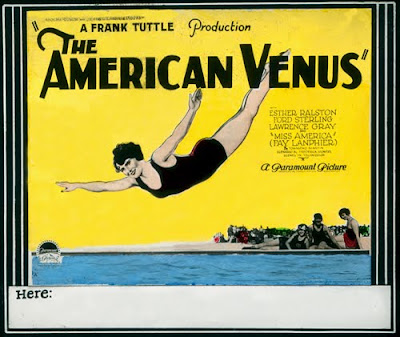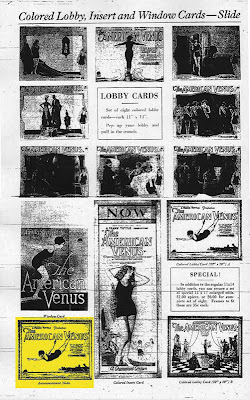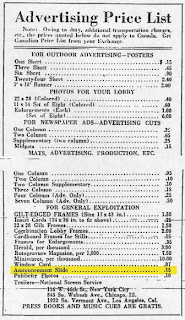Thomas Gladysz: Louise Brooks and “The American Venus”
August 3, 2010
It gives me great pleasure to introduce special guest contributor: Thomas Gladysz! Thomas is an arts journalist, author, founder of the Louise Brooks Society, and great friend of STARTS THURSDAY!

The coming attraction slide for “The American Venus” heralded the arrival of a major new release in early 1926. The film, from Paramount (then known as Famous Players Lasky), was a romantic comedy set at a beauty pageant. Typical for its time, the film featured plenty of pretty girls in bathing suits - and even less, as certain groups in the American Midwest were to complain.
The film was billed as a “novel and magnificent beauty-comedy special.” What made it special was not only its all-star cast, but also the fact that some scenes were filmed in Technicolor. “The American Venus” was one of the earlier films to feature the then new color process.
Parts of “The American Venus” were shot at the 1925 Miss America contest in Atlantic City, New Jersey - where Oakland, California resident Fay Lanphier was crowned that year’s Miss America. It’s her image depicted on the coming attraction slide.

As the winner of the beauty contest, Lanphier was given a movie contract and starring role in “The American Venus.” The film was directed by reliable Frank Tuttle, and was based on a story by Townsend Martin (a Princeton friend of F. Scott Fitzgerald). And, according to the New Yorker and other publications, humorist Robert Benchley wrote the inter-titles.
The cast includes lovely Esther Ralston (nicknamed the “American Venus”), San Francisco-born leading man Lawrence Gray, comedian Ford Sterling, and up-and-comer Louise Brooks in her second film. Renowned artist W.T. Benda, character actor Ernest Torrence, and Douglas Fairbanks Jr. also have supporting roles.
In the 1920’s, national beauty contests were a recent phenomenon. And in this age of ballywho, considerable press coverage was given over to just about every facet of the contest. That’s why Lanphier – then enjoying the peak of her celebrity – was featured on the glass slide. This was the nation’s chance to see moving pictures of the current Miss America!

As with other films, the coming attraction slide was only one aspect of the studio’s overall promotional campaign. On this rough photocopy of the Paramount press book for “The American Venus,” the “announcement slide” (lower left corner) is shown along with window and lobby cards. Such materials were made available through the studios and local film exchanges, which supplied exhibitors with an array of promotional materials. The glass announcement slide costs 15 cents, the same price as a one sheet poster.
Fay Lanphier enjoyed considerable fame after winning the 1925 Miss America contest; she wrote articles, judged local beauty contests, and made personal appearances around the country – many in conjunction with the screening of “The American Venus.” However, her movie career never developed. Lanphier appeared in only one other film, a Laurel and Hardy short entitled “Flying Elephants” (1928). Later, the honey-blond beauty worked as a stenographer in Hollywood.
Today, “The American Venus” is considered a lost film. All that remains are its ephemeral material culture – like glass slides, lobby cards, movie heralds, and a couple of trailers uncovered in Australia in the late 1990’s.
---THOMAS GLADYSZ
Thomas Gladysz is an arts journalist and author. Recently, he wrote the introduction to the new “Louise Brooks edition” of Margarete Böhme's classic novel, The Diary of a Lost Girl (PandorasBox Press). He writes and blogs about early film from his book and DVD filled apartment in San Francisco. Gladysz loves reading and writing and old movies. More at www.thomasgladysz.com.
